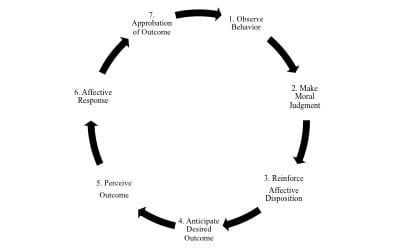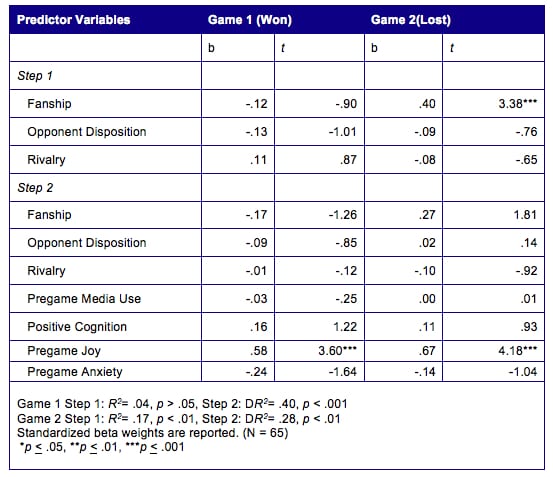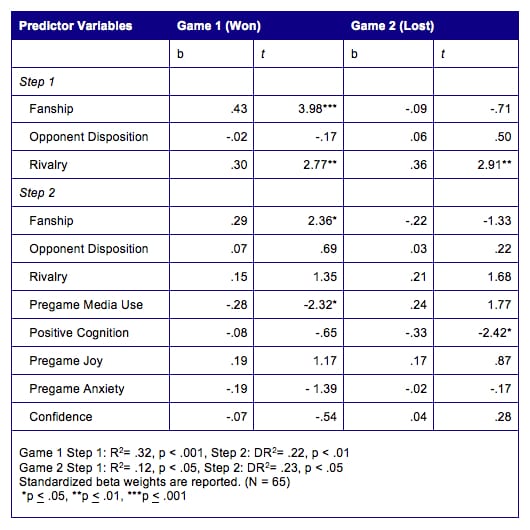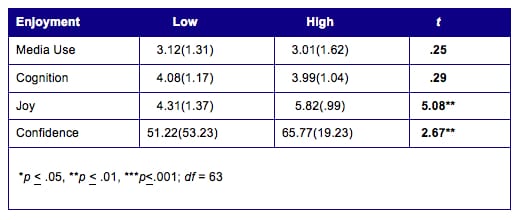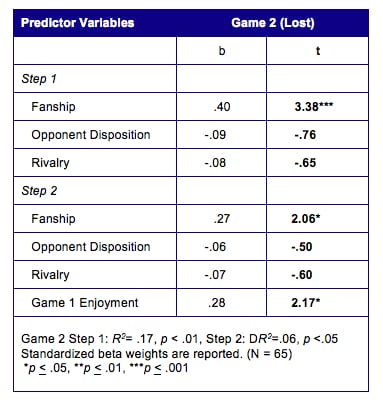William Kinnally, Ph.D.
University of Central Florida

Abstract:
This exploratory study extends our understanding of affective disposition theories (ADT). Two aspects of ADT have received little attention: anticipation and expectations. This project had three goals: 1) examine how anticipation of a contest relates to outcome expectations, 2) examine how anticipation and expectations relate to enjoyment, and 3) extend the disposition theory of sports spectatorship to examine how enjoyment of one contest relates to expectations and enjoyment of a subsequent contest. Three pregame components reflecting anticipation (pregame media use, cognition, and affect) were considered. Anticipated joy was positively related to outcome expectations. When the hometeam won, fanship was associated with increased enjoyment while pregame media use decreased enjoyment. When the favorite team lost, perception of rivalry reduced disappointment but pregame cognition increased disappointment. Additionally, the enjoyment of one game was a predictor of outcome expectations for the next game in the season.
KEYWORDS: Affective Disposition Theories, Decision Affect Theory, Expectations, Sports
- Citation
- Author
 William Kinnally, PhD, is an Assistant Professor at the Nicholson School of Communication, University of Central Florida. Dr. Kinnally has 20 years of experience working as a producer, director, and manager in public and non-commercial radio. Jazz music has been a particular area of interest. He produced jazz concert recordings for local and national broadcast and contributed jazz features, profiles, columns, and reviews to various national and regional publications such as Jazziz magazine and The Gainesville Sun. He has also been a freelance programmer for Music Choice, a national cable radio service. William.Kinnally@ucf.edu
William Kinnally, PhD, is an Assistant Professor at the Nicholson School of Communication, University of Central Florida. Dr. Kinnally has 20 years of experience working as a producer, director, and manager in public and non-commercial radio. Jazz music has been a particular area of interest. He produced jazz concert recordings for local and national broadcast and contributed jazz features, profiles, columns, and reviews to various national and regional publications such as Jazziz magazine and The Gainesville Sun. He has also been a freelance programmer for Music Choice, a national cable radio service. William.Kinnally@ucf.edu
This study is an initial step toward understanding how expectations fit into disposition theories by examining how fans’ expectations of the outcome of a competition are related to their enjoyment. The project uses the disposition theory of sport spectatorship as a framework for examining how aspects of cognition, affect, and pregame media use relate to enjoyment. Additionally, Zillmann’s model of disposition processing within a drama is tested in the context of a series of dramatic sports broadcasts.
Theoretical Foundations
Disposition Theory of Sports Spectatorship
Generally speaking, affective disposition theories (ADT) describe the relationship between an individual’s attitudes toward characters and their appreciation of stories about those characters. Disposition theories have been successfully applied to the enjoyment of a variety of content including humor (Zillmann & Cantor, 1976), drama (Zillmann, 1994), crime-based fiction (Raney & Bryant, 2002), sports (Sapolsky, 1980; Zillmann, Bryant, & Sapolsky, 1989; Zillmann & Paulus, 1993) and news (Zillmann and Knobloch, 2001; Zillmann, Taylor, & Lewis, 1998).
The disposition theory of sports spectatorship (Bryant & Raney, 2000; Zillmann, Bryant, & Sapolsky, 1989; Zillmann & Paulus, 1993) suggests a fan’s attitudes toward a team can be described along a continuum of affect from intense liking to intense disliking. Ultimately, the enjoyment of a sports event stems from two key ideas: the strength and valence of the dispositions held toward the competitors, and the outcome of the game.
Many studies have supported the disposition theory of sports spectatorship in a variety of contexts including individual and team contests. Several of the early studies are described by Zillmann, Bryant, and Sapolsky (1989). One study focused on affective dispositions toward professional American football teams. Participants were categorized according to their levels of fanship (positive, neutral or negative disposition toward each team) and asked to watch a live-broadcast of a game between the two teams. The researchers measured enjoyment of every play in the game, as well as the overall contest. They observed that enjoyment of the contest was greatest for viewers who strongly liked the winning team and strongly disliked the losing team. Enjoyment was lowest for viewers who liked the losing team and disliked the winning team.
In another study, Zillmann and his colleagues focused on Olympic basketball. In 1976, the United States played Yugoslavia in the men’s gold medal game. Researchers invited American college students to view a portion of the game and rated their enjoyment of each play. As expected, the American students reported increased enjoyment when the U.S. scored and decreased enjoyment when Yugoslavia scored. Additionally, two members of the U.S. team had played basketball at the university where the research was conducted. Researchers observed that respondents reported greater enjoyment of scoring plays involving those two players than for any other U.S. player. The researchers concluded that the participants held more positive dispositions toward the two former students than the other players on the U.S. squad; therefore, enjoyment was greatest on plays in which they scored.
Given the disposition theory formula involving attitude and outcome, some researchers have suggested that maximum enjoyment from viewing sports should be experienced when an intensely liked team defeats an intensely disliked team. Conversely, minimum enjoyment or maximum disappointment should be experienced when a loved team is defeated by a hated one (Zillmann & Paulus, 1993). In the process of testing this extension of the disposition theory of sports spectatorship using the perception of rivalry as an indicator of disposition, Raney and Kinnally (2006) found support for the extension’s prediction of maximum enjoyment but not minimum enjoyment (maximum disappointment). The results suggested the predictive strength of the disposition theory might be enhanced by considering the viewer’s expectations of the outcome.
Anticipation, Expectations, and Disposition Theory
The enjoyment of sports broadcasts appears to be an appropriate context for examining anticipation, expectations, and enjoyment. Football fans, for example, have some idea of how the teams in a particular game are expected to perform. In all likelihood, they have personal experience watching previous games and/or hearing friends and sports commentators make predictions about the outcome. So, prior to a game, the fans probably have opinions about their team’s chances for success. The question becomes, is there a place for expectations in disposition theories, particularly the disposition theory of sports spectatorship?
Expectations have been implied in accounts of disposition theories but not directly addressed. The implication is evident in Zillmann’s (2000) proposed model of moral sanction theory of delight and repugnance which describes the process audiences go through as they evaluate dramatic characters and experience affective responses as the drama unfolds. In general, the model describes an audience’s observation of character behavior, assessment of the character’s experience, and response to the outcomes the character experiences (see Figure 1). Based on their affective reaction to the character, the audience hopes good things happen to liked characters or fears they might experience bad outcomes. Although the entire model offers a parsimonious perspective on how dispositions are linked to moral judgment and enjoyment, the fourth or “anticipation” stage appears to imply a potential role for expectations.
Figure 1. Interpretation of the model of moral-sanction theory of delight and repugnance (Zillmann, 2000).
Zillmann’s model was intended to describe processing within a dramatic presentation. That is, the judgment and affective reactions associated with one scene would then feed into the observations, judgment, and affect related to subsequent scenes. This loop leaves room for extending the model beyond a single dramatic presentation to programs in a series. It stands to reason that, affective reactions and moral judgments at the end of one drama could influence the processing associated with subsequent dramas involving the same protagonist. The relationship between the enjoyment of one episode in a series and the development of new anticipation and expectations for subsequent episodes has only been addressed in the context of soap opera viewing (Weber, Tamborini, Lee, & Stipp, 2008). In sports, a fan follows a favored team or athlete through a series of dramatic events – a season. Extending Zillmann’s model beyond the single dramatic event suggests the results of one game could have an impact on the anticipation or expectations and the enjoyment of the subsequent game. Given that ADT doesn’t specifically address expectations, it is helpful to turn to expectancy oriented theories such as decision affect theory for direction.
Decision Affect Theory
Decision affect theory (DAT) is a theory of post-decision emotional experience (Mellers, Schwartz, Ho & Ritov, 1997; Mellers, Schwartz, & Ritov, 1999). The theory suggests the impact of expectations in the emotional responses to a win/lose event is derived from situational outcomes. Simply put, DAT suggests that the pleasure resulting from a win-or-lose activity has several components: 1) the actual utility of the outcome, 2) subjective probability of the desired outcome, 3) comparisons between what actually occurred and what was expected, and 4) surprise associated with the actual outcome.
For the purpose of the current study, attention will be directed toward the subjective probability or subjective belief that an outcome a will occur. This is perhaps best described as the level of confidence in the expected outcome. DAT has been applied in the context of the disposition theory of sports spectatorship (Kinnally & Raney, 2010). An individual’s confidence in the outcome expectation was observed as a predictor of enjoyment, but in a limited situation (i.e. when the favored team lost a game against a moderately liked/disliked opponent). This result, combined with Zillmann’s model, suggests the expectations associated with confidence in the outcome might play a role in enjoyment and warrants further examination.
Research Questions and Hypotheses
The first stage of the project focused on the relationship between pregame affect and cognition and the outcome expectations. Zillmann’s model identifies a period of anticipation. The anticipation in Zillmann’s model suggests an internal assessment of the likelihood of a desirable outcome and the affective value associated with the outcome (degrees of desirability). In the context of sports, there are several potential factors that might be considered in the assessment. This gives rise to the following research question:
RQ1: What elements of anticipation (pregame media use, cognitive assessment of the game matchup, pregame affect) appear to be associated with confidence in outcome expectations for the game?
The next stage of the project was designed to examine the impact on enjoyment. Therefore, the next research question attempts to examine how pregame anticipation factors might be related to enjoyment. Additionally, confidence in the expected outcome is expected to be inversely linked to enjoyment such that more confidence in the expected positive outcome (win) leads to less enjoyment of a negative outcome (loss) and vice versa. Therefore, the following research question and hypotheses regarding anticipation, confidence in outcome expectations, and enjoyment are proposed:
RQ2: What elements of anticipation (pregame media use, affect, cognition, and confidence in outcome expectations) appear to be associated with enjoyment of the game?
H2: Compared to those with low levels of confidence that the favored team will win, those with high levels of confidence will report a less enjoyment of a game in which a favored team wins.
H3: Compared to those with low levels of confidence that the favored team will win, those with high levels of confidence will report a less enjoyment (more disappointment) of a game in which a favored team loses.
Finally, the project examines how the model of disposition can be used to address affective impact across dramatic contests. Zillmann’s (2000) model predicts the emotional response to an outcome feeds back to new perceptions and subsequently anticipation. The relationship between the enjoyment of a contest and the development of new anticipation and expectations was evident in the context of soap operas (Weber, Tamborini, Lee, & Stipp, 2008). However, whether the experience of watching a favored team win or lose has an impact on the expectations of a subsequent contest featuring the favored team has not been examined. Therefore, the following hypotheses are posed:
H4: The enjoyment of a game (Game 1) which a favored team wins will be positively associated with the media use, affect, cognition, and confidence in outcome expectations for the following game in the season (Game 2).
H5: The enjoyment of a game which a favored team wins (Game 1) will be a positive predictor of confidence in outcome expectations for the next game in the season (Game 2).
Methodology
Participants
This project involved the voluntary participation of university students in two natural experiments over a two-week period with live sports programming as the stimuli. A total of 115 students began the study but only 65 completed all the required pretest and posttest surveys for the two sequential televised college football games featuring the student’s home team (Mage = 19.9, SD = 1.40; 85% female). The sample size was deemed adequate for an exploratory study when considering the robust nature of disposition theories. Although the women outnumbered men, independent samples t-tests comparing male and female responses for the independent and dependent variables revealed no significant differences for either game (p > .05).
Independent Measures
Fanship. Similar to previous research (e.g., Arpan & Raney, 2003; Raney & Kinnally, 2009) fanship was measured using a 5-item index including measures of pride in the team, how hard they root for the team, and the importance of the team’s success. The items used a 7-point scale ranging from “Strongly disagree” to “Strongly agree.” These were averaged for the Fanship index (α = .96; M = 6.2, SD = 1.20).
Disposition toward Opponents. Participants’ disposition toward opponents was measured using one question: “How do you feel about [opponent team]?” Responses were made on a 7-point scale ranging from “Hate” to “Love.” [MG1 = 3.22, SD = 1.33; MG2 = 3.69, SD = 1.47.]
Rivalry. Level of rivalry was measured with one question (e.g. Raney & Kinnally, 2009): “How big a rivalry does [the favored team] have with [opponent]?” Responses were made on a 7-point scale ranging from “Not at all” to “Extremely.” Rivalry was determined to be significantly different for both games (MG1 = 4.12, SD = 1.78; MG2 = 3.43, SD = 1.68; p < .001).
Pregame Media Use. Media use was measured using a 5-item index reflecting participants’ sports media use during the previous two days. The list included activities such as reading newspaper articles about the hometeam, reading Internet stories, and watching sports TV. The items used a 7-point scale ranging from “Strongly disagree” to “Strongly agree” (Game 1: α = .85; Game 2: α = .88).
Pregame Positive Cognition. Pregame cognition was a 6-item index comprising statements that reflect an assessment of how the hometeam compared to the opponent. For example, “the [opponent] has a better defense than the [hometeam’s] offense.” Negatively phrased items were recoded [Game 1 Cognition: MG1 = 3.61, SD = 1.18, α = .82; Game 2 Cognition: MG2 = 4.02, SD = 1.07, α = .79].
Pregame Affect. Pregame affect was represented by two indexes representing joy and anxiety. The nine items were measured using a 7-point scale ranging from “Strongly disagree” to “Strongly agree.” The joy index was included five items reflecting happiness, joy, and excitement (e.g. “I am excited about the game this week.”). The anxiety index included statements reflecting nervousness and anxiety (e.g. “I am nervous about this week’s game”). [Joy: MG1 = 4.51, SD = 1.52, α = .95; MG2 = 4.51, SD = 1.52, α = .96; Anxiety: MG1 = 3.87, SD = 1.63; MG2 = 3.87, SD = 1.63, α = .91.]
Dependent Measures
Confidence in Outcome Expectation. Participants’ expectation regarding the outcome of the game was measured using a single question: “What are the [hometeam’s] chances of winning this week’s game…?” Participants reported the chance of winning as a percentage (ranging from 0 to 90 percent). Confidence in the hometeam’s ability to win the game differed for the two games (MG1 = 47.46, SD = 22.58; MG2 = 60.85, SD = 21.63).
Enjoyment: The 12-item enjoyment index was drawn from prior research (e.g., Raney, 2005; Raney & Kinnally, 2009) and included statements reflecting participants’ perceptions of the game such as “It was exciting,” “it was enjoyable,” it was well-played.” The items used a 7-point scale ranging from “Strongly disagree” to “Strongly agree” (MG1 = 6.03, SD = 1.02, α = .96; MG2 = 3.96, SD = .91, α = .90).
Mean splits of Game 1 confidence and enjoyment were also used as independent variables in examinations of anticipation and outcome expectations associated with Game 2.
Results
Anticipation and Outcome Expectation Confidence
The first research question (RQ1) examined how anticipation (pregame media use, cognitive assessment of the game matchup, and affective assessment of the game) are related to the confidence in outcome expectations of the game. A hierarchical regression was used to identify significant factors associated with outcome expectations. The first step included three disposition variables: fanship (disposition toward the favored team), disposition toward the opponent, and perceived level of rivalry between the two teams. The second step added the pregame anticipation variables. Responses for the games were analyzed separately (see Table 1). For Game 1, Step 1 was not significant, i.e. none of the disposition-oriented variables predicted confidence in outcome expectations. In Step 2, only pregame affect was a related to expectations that the favored team would win (ΔR2=.40, p < .001). The more positively the viewer felt about the upcoming game, the more confident they were that their favored team would win.
For the second game, which the favored team lost, fanship was the only disposition variable in Step 1 that predicted outcome expectations (R2= .17, p < .01). In Step 2, only pregame affect (joy) predicted outcome expectations (ΔR2= .28, p < .01).
Anticipation, Expectation Confidence, and Enjoyment
Table 1
Disposition and Anticipation Variables as Predictors of Confidence in Outcome Expectation
The second research question addressed the relationship between anticipation and enjoyment of the game (RQ2). A regression analysis similar to the one used in the first research question was used but this time enjoyment was the dependent variable (see Table 2). The two games were analyzed separately. For Game 1, Step 1 was significant with fanship and perception of rivalry serving as positive predictors of enjoyment: the greater the level of fanship or the greater the perception of rivalry, the greater the enjoyment (R2 = .32, p < .001). Of the anticipation variables in Step 2, only fanship and pregame media use were predictors of enjoyment (ΔR2 =.22, p < .01). Fanship was a positive predictor but pregame media use was a negative predictor (i.e. more pregame media use corresponded to less enjoyment).
The results differed for Game 2, which the favored team lost. Step 1 was significant (R2 =.12, p < .05) but only perception of rivalry was associated with enjoyment (i.e. the greater the perception of rivalry, the greater the enjoyment). In Step 2, only pregame cognition was a predictor of enjoyment (ΔR2= .23, p < .05). The more positive the assessment of how the hometeam compared to its opponent was associated with less enjoyment (more disappointment).
Table 2.
Disposition and Anticipation Variables as Predictors of Enjoyment
The next hypotheses focused on the relationship between outcome expectations and enjoyment (or disappointment). Specifically, the confidence in expectation that the hometeam would win was expected to be inversely related to enjoyment of a game in which a favored team wins (H2). A mean split of the confidence in the outcome expectation variable was used to create high and low confidence groups. A t-test revealed no difference in the level of enjoyment between the two confidence groups for Game 1 (Enjoyment: ML = 5.93, SD = 1.12; MH = 6.14, SD = .91; t = -.85, p > .05). The next hypothesis (H3) proposed that those with low confidence in outcome expectation (expectation that the favored team would win would report greater enjoyment (less disappointment) of a game in which the favored team lost (Game 2). A t-test revealed no difference in the level of enjoyment (disappointment) between the two confidence groups (Enjoyment: ML = 3.95, SD = .81; MH = 3.97, SD = 1.02; t = -.08, p > .05). Therefore H2 and H3 were not supported.
Table 3
Game 1 Enjoyment and the Pregame Variables for Game 2
Affective Transference, Anticipation and Expectations
The final hypotheses were intended to examine how the enjoyment of a game which a favored team wins is associated with the affective elements of anticipation such as affective anticipation and outcome expectations for the hometeam‘s next game. For the first part of the analysis, a mean split of the enjoyment of Game 1 was used to compare higher and lower levels of media use, affect and cognition using t-tests. The fourth hypothesis (H4) predicted that greater enjoyment of Game 1 would be associated with higher levels of pregame anticipation for Game 2. The analysis showed that those with higher levels of enjoyment of Game 1 also displayed higher levels of joy and outcome expectations for the upcoming game (See Table 3). Therefore H4 was partially supported.
The last hypothesis (H5) proposed that Game 1 enjoyment would be a predictor of confidence in outcome expectation for Game 2. This association was tested by placing Game 1 enjoyment in a hierarchical regression controlling for disposition (see Table 4). Results showed that fanship was the only significant disposition variable in Step 1 (R2= .17, p < .01). When Game 1 Enjoyment was added as a predictor of Game 2 outcome expectations in Step 2, it combined with fanship to predict outcome expectations (ΔR2=.06, p < .05). Therefore H5 was supported.
Table 4
Game 1 Enjoyment and Confidence in Outcome Expectation
Discussion
This exploratory project was a foray into understanding how anticipation and outcome expectations play a role in affective disposition theories. In this effort, the disposition theory of sports spectatorship serves as a framework for examining how fans’ anticipation of a game was related to their outcome expectations and enjoyment. The finite outcomes (winning or losing) of sports contests and the season-oriented structure of college football in particular, made sports content particularly well suited for this examination. The study resulted in several valuable observations relating to each of the intended goals.
The first goal of the study focused on confidence in outcome expectations. Decision affect theory (DAT) – a model for understanding emotional experiences (enjoyment) associated with win/loss propositions – suggests that confidence in an expected outcome influences affective reactions. Three pregame components reflecting anticipation (pregame media use, cognition, and affect) were combined with the traditional affective variables associated with disposition theories in order to identify which, if any, were related to the confidence in outcome expectations. The analysis enabled us to observe the role of disposition variables like fanship and then control for those variables while examining the anticipation variables. Interestingly, the disposition variables did not play a role in the confidence in the outcome expectations. Additionally, the only factor predicting confidence that the favored team would win was a person’s positive affect or joy about the upcoming contest. The participants’ feelings about the game were more strongly associated with confidence than their thoughts about how the favored team compared to the opponent. This affective orientation suggests outcome expectations could be a good fit for disposition theories. Further, the fact that these emotions appear to be separate from the traditional disposition variables (i.e. fanship) suggests a complementary relationship that warrants further examination.
The second goal of the study was to examine the relationship between pregame factors including confidence and enjoyment. However, participants’ confidence that their hometeam would win the game was not related to their enjoyment of the game. The relationship between expectations and enjoyment has only begun to be explored and a connection has been observed. However, this confidence measure had not been previously used. So, the lack of association to enjoyment might be attributed to limitations of the measure to capture “expectations.” The lack of findings might also be attributed to the sample size in the study. Disposition effects tend to be robust as is evident in other parts of this project. However, confidence may have a small role that is difficult to observe with the size of the sample. One challenge of conducting unfunded, longitudinal research with natural experiments is the ability to involve large samples. As a result, the findings related to confidence should be viewed as a call for further examination.
The broader perspective of how pregame expectations were associated with enjoyment included disposition-based variables as well as pregame activity and anticipation variables. Looking first at the game the hometeam won, fanship and pregame media use predicted enjoyment. The most enthusiastic fans enjoyed the game more, which make sense. However, people who experienced more pregame media coverage were more likely to report less enjoyment. In some way, the media exposure was connected to a dampening of enjoyment. For the game the hometeam lost, participants who thought the hometeam compared favorably to the opponent reported less enjoyment (more disappointment) after the loss.
The results highlight a role for anticipation variables in enjoyment. They show that joy and enthusiasm for an upcoming game shapes the belief about the team’s chances for success. But when it comes to the emotional response to the game, pregame affect and pregame cognition do not effect enjoyment of a win. In fact, only the pregame media use did, but in a negative way. Different results were observed in the game the favored team lost, where the only factor related to enjoyment (disappointment) was the participant’s assessment of the team’s quality. In both cases, there appears to be a contrast in how the win/loss outcomes are processed.
The final goal of the study was to extend Zillmann’s model of disposition to reflect processing within a dramatic series. The model includes a loop that shows affect and judgment feeding back into subsequent perception of a character and leaves room to extend the model beyond a single drama to programs within a series. The study examined two parts of the equation; the relationship between enjoyment of a game won and anticipation and expectations for the next game. Comparisons between those who experienced lower and higher levels of enjoyment following Game 1 indicates support for the extension of Zillmann’s model. The joyful anticipation of the next game was strongly linked to the enjoyment of the previous game. People who really enjoyed Game 1 had stronger positive feelings in anticipation of the next game and more confidence in the team’s chances of winning the game. The second approach was to examine the enjoyment of the one game as a predictor of outcome expectations for the next. Again, enjoyment appeared to be a positive predictor of outcome expectations.
Conclusion
Zillmann’s model of disposition suggested potential roles for anticipation and expectations in the enjoyment of drama. Other theories (e.g. DAT) predict relationships between expectation and enjoyment. Although this study found no support for the role of confidence, looking more carefully at the anticipation component of the disposition model, it appears as though there are connections between expectations and enjoyment. Such results suggest further investigation of the role of anticipation in enjoyment of drama is warranted. Overall, research in entertainment theory has largely ignored the impact of anticipation and expectation on enjoyment. This exploratory study served the purpose of taking a small step toward determining aspects of anticipation and expectation work with affective disposition to predict enjoyment.
References
Arpan, L., & Raney, A. A. (2003). An experimental investigation of news source and the hostile media effect. Journalism and Mass Communication Quarterly, 80, 265-281.
Bryant, J. & Raney, A. A. (2000). Sports on the screen. In D. Zillmann & P. Vorderer (Eds.), Media entertainment: The psychology of its appeal (pp. 153-174). Mahwah, NJ: Erlbaum.
Kinnally, W., & Raney, A. A. (2010, April). Expectation, disposition, and enjoyment: Examining the role of expectations in the disposition theory of sports spectatorship. Paper presented at the annual meeting of the Broadcast Education Association, Las Vegas.
Mellers, B. A., Schwartz, A., & Ritov, I. (1999). Emotion-based choice. Journal of Experimental Psychology, 128, 332–345.
Mellers, B. A., Schwartz, A., Ho, K., Ritov, I. (1997). Decision affect theory: Emotional reactions to outcomes of risky options. Psychological Science, 8(6), 423-429.
Raney, A. A. (2005). Punishing media criminals and moral judgment: The impact on enjoyment. Media Psychology, 7(2), 145-163.
Raney, A. A. (2006). The psychology of disposition-based theories of media enjoyment. In J. Bryant & P. Vorderer (Eds.), Psychology of entertainment (pp. 137-150). Mahwah, NJ: Erlbaum.
Raney, A. A., & Bryant, J. (2002). Moral judgment in crime drama: An integrated theory of enjoyment. Journal of Communication, 52, 402-415.
Raney, A. A., & Kinnally, W. (2006). The thrill of victory and the agony of defeat? The complexity of enjoyment in rivalry game wins and losses. Paper presented at the annual meeting of the International Communication Conference, Dresden, Germany.
Raney, A. A., & Kinnally, W. (2009). Examining perceived violence in and enjoyment of televised rivalry sports contests. Mass Communication and Society, 12(3), 311 – 331.
Sapolsky, B.S. (1980) The effect of spectator disposition and suspense on the enjoyment of sport contests. International Journal of Sport Psychology, 11, 1-10.
Wann, D. L. (1995). Preliminary validation of the sport fan evaluation scale. Journal of Sport and Social Issues, 19, 377-396.
Wann, D. L., Schrader, M. P., & Wilson, A. M. (1999). Sport fan motivation: Questionnaire validation, comparisons by sport, and relationship to athletic motivation. Journal of Sport Behavior, 22, 114-139.
Weber, R., Tamborini, R., Lee, H. E., & Stipp, H. (2008). Soap opera exposure and enjoyment: A longitudinal test of disposition theory. Media Psychology, 11(4), 462-487.
Zillmann, D. (1994). Mechanisms of emotional involvement with drama. Poetics, 23, 33-51.
Zillmann, D. (2000). Basal morality in drama appreciation. In I. Bondebjerg (Ed.), Moving images, culture, and the mind (pp. 53-63). Luton, U. K.: University of Luton Press.
Zillmann, D., Bryant, J., and Sapolsky B. S. (1989). Enjoyment from sports spectatorship. In J. H. Goldstein (Ed.), Sports, games, and play: Social and psychological viewpoints (2nd ed., pp. 241-278). Hillsdale, NJ: Erlbaum.
Zillmann, D. & Cantor, J. (1976). A disposition theory of humor and mirth. In T. Chapman & H. Foot (Eds.), Humor and laughter: Theory, research and application. London: Wiley: 93-115.
Zillmann, D., & Knobloch, S. (2001). Emotional reactions to narratives about the fortunes of personae in the news theater. Poetics, 29, 189-206.
Zillmann, D., & Paulus, P. B. (1993). Spectators: Reactions to sports events and effects on athletic performance. In R. N. Singer, M. Murphey, & L. K. Tennant (Eds.), Handbook of research on sport psychology (pp. 600-619). New York: Macmillan.
Zillmann, D., Taylor, K. & Lewis, K. (1998) News as nonfiction theater: How dispositions toward the public cast of characters affect reactions. Journal of Broadcasting & Electronic Media, 42, 153-169.
 Media Psychology Review Journal for Media Psychology
Media Psychology Review Journal for Media Psychology

